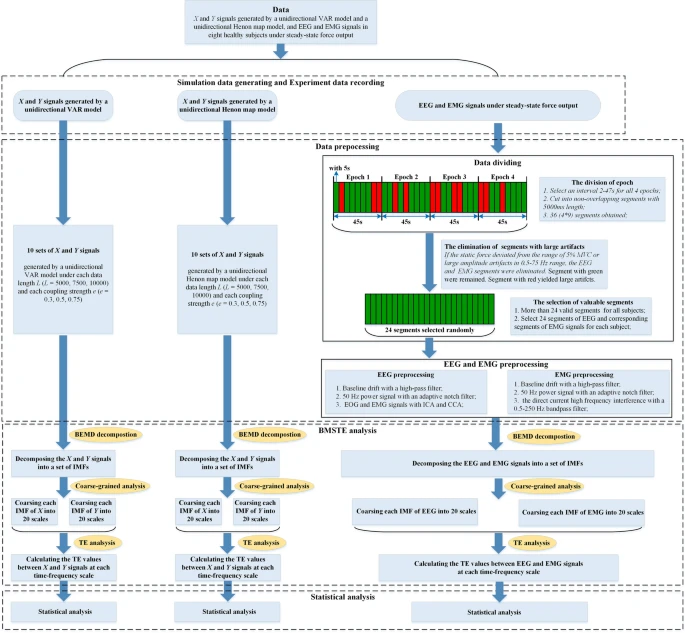


Shengcui Cheng, Xiaoling Chen*, Yuanyuan Zhang, Ying Wang, Xin Li, Xiaoli Li, Ping Xie*
The multiscale information interaction between the cortex and the corresponding muscles is of great significance for understanding the functional corticomuscular coupling (FCMC) in the sensory-motor systems. Though the multiscale transfer entropy (MSTE) method can effectively detect the multiscale characteristics between two signals, it lacks in describing the local frequency-band characteristics. Therefore, to quantify the multiscale interaction at local-frequency bands between the cortex and the muscles, we proposed a novel method, named bivariate empirical mode decomposition—MSTE (BMSTE), by combining the bivariate empirical mode decomposition (BEMD) with MSTE. To verify this, we introduced two simulation models and then applied it to explore the FCMC by analyzing the EEG over brain scalp and surface EMG signals from the effector muscles during steady-state force output. The simulation results showed that the BMSTE method could describe the multiscale time–frequency characteristics compared with the MSTE method, and was sensitive to the coupling strength but not to the data length. The experiment results showed that the coupling at beta1 (15–25 Hz), beta2 (25–35 Hz) and gamma (35–60 Hz) bands in the descending direction was higher than that in the opposition, and at beta2 band was higher than that at beta1 band. Furthermore, there were significant differences at the low scales in beta1 band, almost all scales in beta2 band, and high scales in gamma band. These results suggest the effectiveness of the BMSTE method in describing the interaction between two signals at different time–frequency scales, and further provide a novel approach to understand the motor control.
大脑皮层与相应肌肉之间的多尺度信息交互对于理解感觉-运动系统中的皮质-肌肉功能耦合(FCMC)具有重要意义。虽然多尺度传递熵(MSTE)方法能有效检测两个信号之间的多尺度特征,但它在描述局部频带特征方面存在不足。因此,为了量化大脑皮层与肌肉之间局部频段的多尺度相互作用,我们提出了一种新方法,将双变量经验模式分解(BEMD)与多尺度传递熵相结合,命名为双变量经验模式分解-多尺度传递熵(BMSTE)。为了验证这一点,我们引入了两个仿真模型,然后通过分析稳态力输出时大脑头皮上的脑电图和效应肌表面的肌电信号,将其用于探索 FCMC。仿真结果表明,与 MSTE 方法相比,BMSTE 方法能够描述多尺度时频特征,并且对耦合强度敏感,而对数据长度不敏感。实验结果表明,β1(15-25 Hz)、β2(25-35 Hz)和γ(35-60 Hz)波段在下降方向的耦合度高于对立方向,β2 波段高于β1 波段。此外,β1 波段的低尺度、β2 波段的几乎所有尺度以及伽马波段的高尺度均存在明显差异。这些结果表明,BMSTE 方法能有效地描述两个信号在不同时频尺度上的相互作用,并进一步为理解运动控制提供了一种新方法。